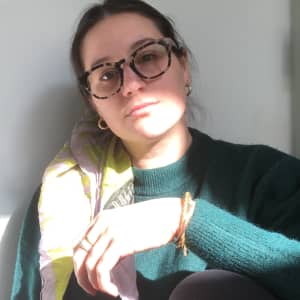Fashion Designer Career Guide: Education and Salary Overview
- What Is a Fashion Designer
- How Many Years Does It Take?
- How to Become A Fashion Designer
- Fashion Designer Salary
- Fashion Design Organizations
- Interview With a Fashion Designer
- FAQs
Key Takeaways
- Most fashion designers hold a bachelor’s degree in art or design and gain industry experience through internships, portfolio projects, and entry-level roles.
- Successful designers combine creative and technical skills with marketing and business knowledge to launch lines, freelance, or work for major brands.
- Networking, staying current on fashion trends, and developing a distinctive portfolio help designers advance in a competitive, fast-paced industry.
A fashion designer creates original apparel and accessories. Drawing on fashion trends and a deep knowledge of textiles and style, designers turn their vision into a reality.
Careers in fashion design also require business training. Successful designers blend creativity with solid skills in marketing, sales, and management. Most fashion designers hold a bachelor’s degree.
The fashion design career offers above-average salaries. But how do fashion designers start their careers? Like other art and design careers, fashion designers often put in long hours before breaking into the industry. This page explores how to become a fashion designer.
What Is a Fashion Designer?
Fashion designers are the visionaries shaping our style. These professionals create and design clothing and accessories, often specializing in areas like high fashion, mass-market clothing, sportswear, or footwear.
They research fashion trends, use design software, and collaborate with designers to develop innovative designs. At the beginning of a design project, fashion designers typically make sketches, evaluate textiles, and create a prototype.
What Do Fashion Designers Do?
After earning a four-year degree, designers often work as stylists, fashion buyers, and assistants to established designers. These roles help them expand their skills and build a network. With a more established portfolio, designers can work their way up to major brands or forge their own path as an independent designer.
Some designers create their own collections or fashion lines, designing pieces to show during fashion weeks in major cities like New York, Paris, Milan, and London. Other designers work for major brands, pitching ideas to creative directors and designing seasonal lines for the brand.
Where Do Fashion Designers Work?
Many fashion designers work for major fashion brands on the wholesale and manufacturing sides. In these roles, they create apparel and accessories that brands distribute to retailers. Nearly a quarter of fashion designers work in freelance roles, where they contract with clients to create pieces.
The career often requires long hours and travel. Designers who work on production deadlines or put together fashion shows often work long hours. Most fashion designers based in the U.S. work in New York or Los Angeles.
What Skills Do Fashion Designers Need?
Fashion careers require creative, practical, and business skills. Designers use their creativity to develop ideas and need good communication, teamwork, and attention to detail. They also rely on technical skills like using design software and making clothes.
Running a fashion business also requires marketing, sales, and management skills. Self-employed designers use sales and product development skills to meet customer needs.
Reality Check: How Long Does It Take To Become a Fashion Designer?
Most fashion designers hold a bachelor’s degree, which takes about four years to complete. However, breaking into the field doesn’t happen overnight.
Upon completing your degree, it can also take time to network and build a portfolio, both of which are essential for a successful career in fashion. Overall, you can expect to spend 4-6 years breaking into the industry.
How to Become a Fashion Designer: 4 Key Steps
Earning a fashion design degree can help you launch your career. But a degree alone does not guarantee success. To find success as a fashion designer, you also need a strong portfolio, work experience, and a professional network to break into the fashion industry.
Successful fashion designers work their way up. Many start building skills long before entering a fashion program. Learning how to sew, following fashion trends, and practicing with design software can all help you gain admission to competitive fashion programs.
- Complete a fashion design degree program.
- Gain hands-on experience.
- Network within the industry.
- Build your design portfolio.
Step 1: Earn a Four-Year Bachelor’s Degree
Most fashion designers have a bachelor’s degree in art and design. In a fashion design program, you learn about fabrics, fashion and color theory, and how to create designs using computer-aided design (CAD) software. You complete projects to build your skills and portfolio.
These programs also include merchandising, business, and marketing classes, which help designers understand customer demand and how to make a profit. Many students finish the program by creating a clothing line for a school fashion show.
Step 2: Gain Hands-On Experience
A degree in fashion design or merchandising is helpful, but hands-on experience is also important. Many colleges help you find internships where you can learn from experienced designers and gain real-world business experience.
You can also look for part-time or contract jobs. Working with a small brand helps you grow your portfolio and may lead to starting your own line. Experience with a big brand strengthens your resume and helps you make useful connections.
Step 3: Network Within the Industry
Like other artistic fields, networking helps fashion designers find professional opportunities, secure clients, and advance their careers. You should begin networking as early as possible, even before entering a fashion program. Networking events in school offer a valuable resource for meeting professionals in the fashion industry.
Connect with other designers, suppliers, buyers, and everyone else in the industry. Those connections can pay off once you begin freelancing or applying to full-time positions.
Step 4: Build Your Design Portfolio
Fashion careers require a strong design portfolio. Many designers build their portfolios before school and add to them during their program. A good portfolio shows variety, like everyday wear and high-fashion designs, or highlights technical skills.
You’ll need to keep updating your portfolio throughout your career. Internships, entry-level jobs, and a stylist’s work can help add new pieces. Since fashion changes often, it’s important to follow trends and stay updated on industry news.
How Much Do Fashion Designers Make?
Fashion designers earn above-average salaries. According to the Bureau of Labor Statistics (BLS), fashion designers earned a median annual salary of $80,690 in 2024, with the top 10% of highest-paid designers earning more than $169,620.
Salaries vary depending on your experience, industry, and location. As the tables below show, there are several industries in which designers earn average salaries of over $100,000.
Fashion Designer Salary and Job Outlook
$80,690
Median Salary (2024)
21,900 (2023)
Total Employment
5% (or +1,000 jobs)
Projected Job Growth (2023-33)
Fashion Designer Salary: By Industry
Salaries for fashion designers vary depending on their industry. According to the BLS, fashion designers working in apparel, piece goods, and notions merchant wholesalers earn about 10% more than those working in apparel knitting mills. Below are the top-paying industries for fashion designers.
| Industry Name | Total Employment | Annual Mean Wage (2023) |
|---|---|---|
| Apparel, Piece Goods, and Notions Merchant Wholesalers | 7,820 | $106,400 |
| Motion Picture and Video Industries | 610 | $99,800 |
| Management of Companies and Enterprises | 3,720 | $99,710 |
| Employment Services | 230 | $98,910 |
| Apparel Knitting Mills | 30 | $96,430 |
Fashion Designer Salary: By State
Salaries for fashion designers also differ by state. Several factors influence the highest-paying states, including how concentrated the industry is there and the cost of living. Here are the top-paying states for fashion designers.
| States | Total Employment | Annual Mean Wage |
|---|---|---|
| Massachusetts | 440 | $104,210 |
| New York | 7,930 | $99,020 |
| New Hampshire | 80 | $96,450 |
| New Jersey | 330 | $96,290 |
| Arkansas | 170 | $94,490 |
Employment numbers vary significantly by state. Some states employ more designers due to their fashion industry hubs, while others may offer lower employment but more competitive wages. Here are the top states employing fashion designers.
| States | Total Employment | Annual Mean Wage |
|---|---|---|
| New York | 7,930 | $99,020 |
| California | 4,950 | N/A |
| Texas | 920 | $53,500 |
| Oregon | 850 | N/A |
| Florida | 760 | $64,740 |
Professional Organizations for Fashion Designers
Several resources help fashion designers stay current. Professional organizations, fashion magazines, and fashion shows showcase trends and industry information. Following other fashion designers and watching red carpet events can also help you keep up with trends.
College Navigator
The National Center for Education Statistics maintains this directory, which allows students to search for colleges by state, degree type, available programs, and institution type.The Fashion Group International
Founded by the editor of Vogue in 1938, the Fashion Group International represents apparel, accessories, beautify and home professionals. Members benefit from educational resources, market data, and networking opportunities.Council of Fashion Designers of America
CFDA dates back to 1962 and advocates for American fashion designers. The council publishes the Fashion Calendar, hosts fashion awards, and provides industry insights on the profession. CFDA also offers sustainability resources.United States Fashion Industry Association
USFIA encourages global fashion by advocating for fewer tariffs and barriers to fashion. The association offers research and reports on the field, a webinar library, and a career center for job seekers.
Interview With a Fashion Designer
To understand what a career in anesthesiology looks like, we have interviewed an expert in the field. Learn more about his experiences.

Carolina Dalfó is a fashion designer based in New York. Her academic career includes a BA in fashion and textile design from UADE in Buenos Aires and an MA in critical theory and the arts from the School of Visual Arts in New York City.
She has experience working for leading brands such as Ralph Lauren, Robert Geller, Opening Ceremony, and Gustav Von Aschenbach. She has also worked on special projects and collaborations with companies such as Lululemon and Dreamworks. Dalfó is also the founder and chair of LATA — the Latinx Alumni Together in the Arts Association at the School of Visual Arts — and the owner and designer of DALFO.
What are the most rewarding and challenging aspects of your career?
The most rewarding aspect of being a designer is seeing people feel good in something I’ve created. Clothes should ultimately enhance the human experience, and when one gets to a point of creation where garments contribute to someone’s confidence, it’s something to be proud of.
At the same time, fashion design is a competitive, busy, and fast-paced industry. The nature of it can be exhausting, even frustrating at times.
When the road to becoming a fashion designer was challenging, what kept you going?
Working in fashion in New York is a dream come true, but being far from home is very hard sometimes. The key for me was to always look at the bigger picture, aim for that image I created for myself, and put in the work to get there. I now know that not everything will go as expected, but everything will be a learning experience on the way to where I want to be.
Granted, this is hard to understand when something doesn’t go as planned, but the best way is through. Letting all the effort I’ve put in go to waste was never an option for me, so I’d allow myself to feel my feelings and keep going.
What type of person is successful and thrives in a fashion career? What type of person may not be the best fit?
Many different types of people are successful in fashion. What they all have in common is that they haven’t only perfected their skills, but they’ve developed their own taste and aesthetic preferences and understand them really well.
Knowing how to take criticism is a big part of this job. If someone struggles with this, it doesn’t mean they are not a good fit for fashion — just that they might need to work on accepting critique on their work.
What’s a typical day for a fashion designer? Who do you work with?
I work on every step of the design process, from the initial research and designing a collection to fitting the sample garments and making corrections with the technical designers.
I prefer sketching by hand to get my ideas flowing, but I do my job sketching in Illustrator and sometimes in a 3D program. It’s a lot of screen time and a lot of editing and reviewing. The installed idea that fashion is a glamorous world is not entirely true. It’s a very hands-on career.
I communicate with several different teams permanently every day. I mostly work closely with product developers and technical designers, who are in charge of the construction of a garment and setting up fittings for designers.
I also work with a graphics team and a prints team, as well as with other design teams, such as woven shirts and outerwear. Besides communicating with creatives, my team also works close to the merchandising team, who dictate the seasonal collection needs. It really is a huge team effort.
Since becoming a fashion designer, has there been anything about the role that you didn’t expect or anticipate?
Absolutely! Fashion design school does not reflect the reality of being a fashion designer accurately. It is very idealistic and abstract. It surprised me to see how much weight departments like merchandising have, for example.
At the end of the day, you need to make money to keep your company in business, and contrary to that, designers are trained to look to the future and experiment. It took me a while to find the right balance between pushing for newness through experimentation and creating something that makes a profit without feeling like a “sell out.”
What would you recommend that students do, in addition to their fashion design degree programs, in order to stand out to employers?
Anything they genuinely find interesting [that] they could use to fuel their designs. When interviewing, I was always drawn to candidates who had something they were passionate and knowledgeable about, which they could take elements from to add to their own creations. It’s about differentiating yourself and bringing something new to the table.
Frequently Asked Questions About the Career and Education Path for Fashion Designers
Several top schools in the U.S. offer fashion design programs. In New York City, Parsons School of Design and the Fashion Institute of Technology are well known for their industry connections and creative approach. Other top choices include the Savannah College of Art and Design (SCAD) in Georgia and the Rhode Island School of Design (RISD).


